Near Eastern Art
Gallery 3
Many of these images came from the Oriental Institute at the University of Chicago.
Due to the number of images on this page, it takes
a while to load.
Why not take a break and grab a cup of coffee and
a fresh danish. You might be here for a few.
Anatolia
![]()
 |
Turkey: Alishar Huyuk, Stratum II
Assyrian Colony Period, ca. 1900-1750 B.C. Baked clay, slipped and burnished 28.0 cm H, 16.0 cm W This gracefully shaped pitcher was a mortuary gift
in a communal burial chamber. The highly polished exterior has a brown-red
slip and shows striations of the polishing stone. Two breast-like protuberances
placed on the upper body of the vessel lend it a slight anthropomorphic
air. The elegant spout curves upward from the neck and is supplied with
a strainer to remove impurities from the liquid that was poured through
it.
|
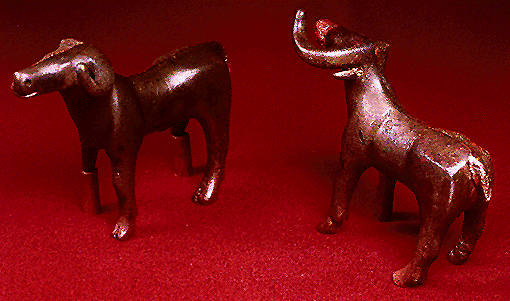 |
Turkey (Central Anatolia)
Early Bronze Age ca. 2300-2000 B.C. Bronze with copper-arsenic plating 9.1 cm H, 11.1 cm W 9.5 cm H, 10.8 cm W These two bulls probably once adorned the top of a
royal or divine standard (or the tops of a pair of such standards). The
treatment of their surfaces is unusual-one half of each bull was covered
with what may be a copper-arsenic plating (probably originally silver in
color), the other half with copper. While the copper surface has become
corroded, the portion covered with the arsenical metal remains essentially
intact.
|
Syria
![]()
 |
Syria: Tell Judaidah Early Bronze Age
(Amuq Phase G), ca. 3100-2900 B.C. Bronze with silver-rich alloy 26.5 cm H, 6.4 cm W Archaeologists found these statuettes in a cache that
contained three male and three female figurines. They are the earliest
known metal castings of human figures in the round from Syria. The males
wear broad belts and helmets covered with a silver alloy; they probably
once held weapons in their upraised hands. The naked females' hair is held
in place with a headband and bound in the back in an elaborate chignon.
They cross their arms and grasp their breasts in their hands - a common
ancient pose that probably connotes fertility. The statuettes were intended
to be mounted in some fashion, for a tang projects below the feet of each
one.
|
 |
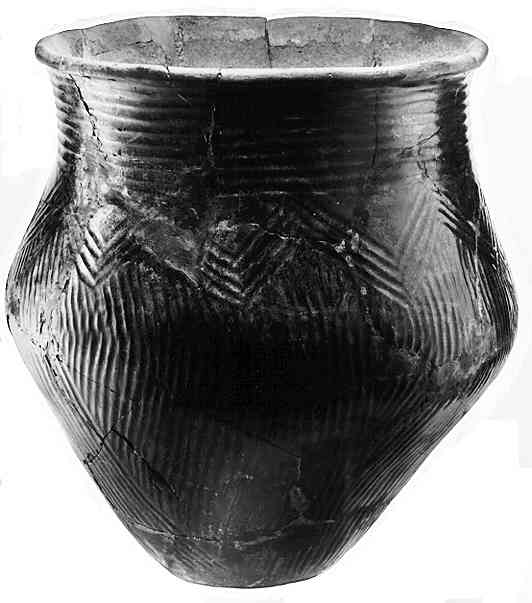 |
Syria: Tell Ta'yinat, T 4, floor 5
Early Bronze Age (Amuq Phase H), ca. 2900-2500 B.C. Baked clay, slipped and burnished 45.0 cm H, 42.0 cm W This jar is made of a specific ware named after the
Palestinian site of Khirbet Kerak, where it was first discovered. Vessels
of Khirbet Kerak ware were made by hand and covered both inside and out
with a brilliantly polished slip, originally orange-red in color (as on
the interior of this vessel) but turned to black on the exterior by specialized
treatment during firing. This large pot bears a typical decoration of horizontal
and vertical flutings separated by zigzags, perhaps in imitation of fluted
metal prototypes.
|
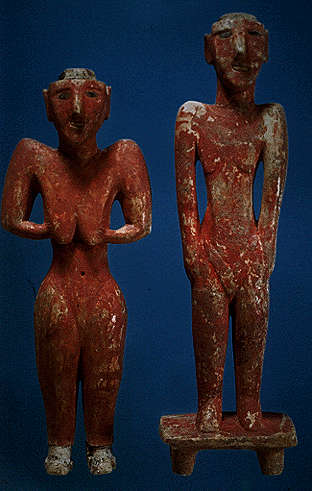 |
Syria: Tell Fakhariyah
ca. 1300-1000 B.C. Gypsum, painted, inlaid with bitumen and stone male - 33.5 cm H, 10.0 cm W female - 29.7 cm H, 11.0 cm W A naked female and a partially clothed male are represented
by this unique pair of red-coated stone figurines. Hair or headdresses
made of a separate material were probably once attached to the pegs atop
their heads. The male, who stands with his hands at his sides, wears a
loincloth tied at the back. The female grasps her breasts with her hands-a
common ancient pose that probably connotes fertility. She appears to be
naked except for some type of foot-gear applied to her stump-like feet.
|
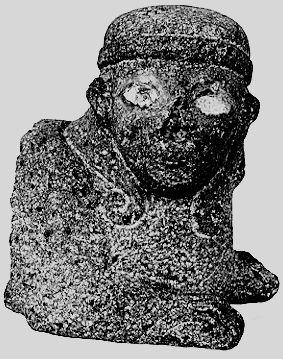 |
Syria: Tell Ta'yinat, Building 1, floor 2
Iron Age (Amuq Phase O), ca. 800 B.C. Basalt inlaid with white and green stone 25.4 cm H, 24.4 cm W Sphinxes-imaginary creatures composed of a lion's body and a human head-are a motif that originated in Egypt and became common in the art of Western Asia beginning in the latter part of the second millennium B.C. This recumbent sphinx of local Syrian manufacture has an unusually vivacious character due to the position of the head, which is turned sideways with the chin slightly raised, not at the stiff right angle often found in ancient Near Eastern sculpture. Its hair is secured with a headband knotted at the back of the head and falls in two large curls onto its breast. The dowel hole in the base of the body indicates that it was part of some large object-possibly an arm of a stone throne. |
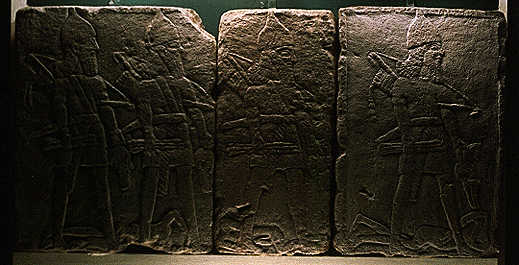 |
Syria: Tell Ta'yinat, Building VII Iron Age
(Amuq Phase O), ca. 750-725 B.C. Limestone 62.0 cm H, 125.0 cm W After they had conquered Tell Ta'yinat, the Assyrians carved these reliefs and used them to decorate a palace or public structure. The scene shows victorious Assyrian soldiers carrying the cut-off heads of their defeated enemies to a location where the number of those slain would be counted. Beneath the soldiers' feet lie the decapitated bodies. Each soldier wears a helmet, carries a bow and quiver over his shoulder, and holds three arrows in his right hand. At a later date, perhaps after the decline of Assyrian power, the reliefs were reused, face-down, as paving stones. |
 |
Syria: Tell Ta'yinat
Iron Age (Amuq Phase O), ca. 1000-500 B.C. Baked clay, painted 12.0 cm H, 8.1 cm W Vessels such as this one were imported into Syria from
Cyprus in ancient times, during a period of strong commercial contacts
between that island and the Levant. This juglet belongs to a type of pottery
known as bichrome ware because of its painted decoration in black and red.
It is the work of a talented potter who used geometric ornament-such as
the concentric circles on the globular body-not only to harmonize with,
but even to enhance, the shape of the vessel.
|
![]()
|
|